Analysis of Financial Accounting Standards and Delta Ltd. Case
VerifiedAdded on 2023/04/03
|7
|1245
|76
Report
AI Summary
This report provides an overview of financial accounting, emphasizing its role in preparing financial statements and adhering to accounting standards. It details AASB 137 concerning contingent liabilities, explaining their definition and disclosure requirements, illustrated by the case of Delta Ltd. The report further discusses AASB 138 on intangible assets, focusing on recognition criteria and cost considerations, and AASB 136 on impairment of assets, highlighting the assessment of carrying amounts and recoverable amounts. A comparison between AASB 138 and AASB 136 clarifies their differing accounting treatments based on economic benefits versus potential losses. The report also touches on companies' perspectives regarding intangible assets and internal goodwill. Ultimately, the report concludes by underscoring the importance of accounting standards in maintaining accurate and transparent financial statements.
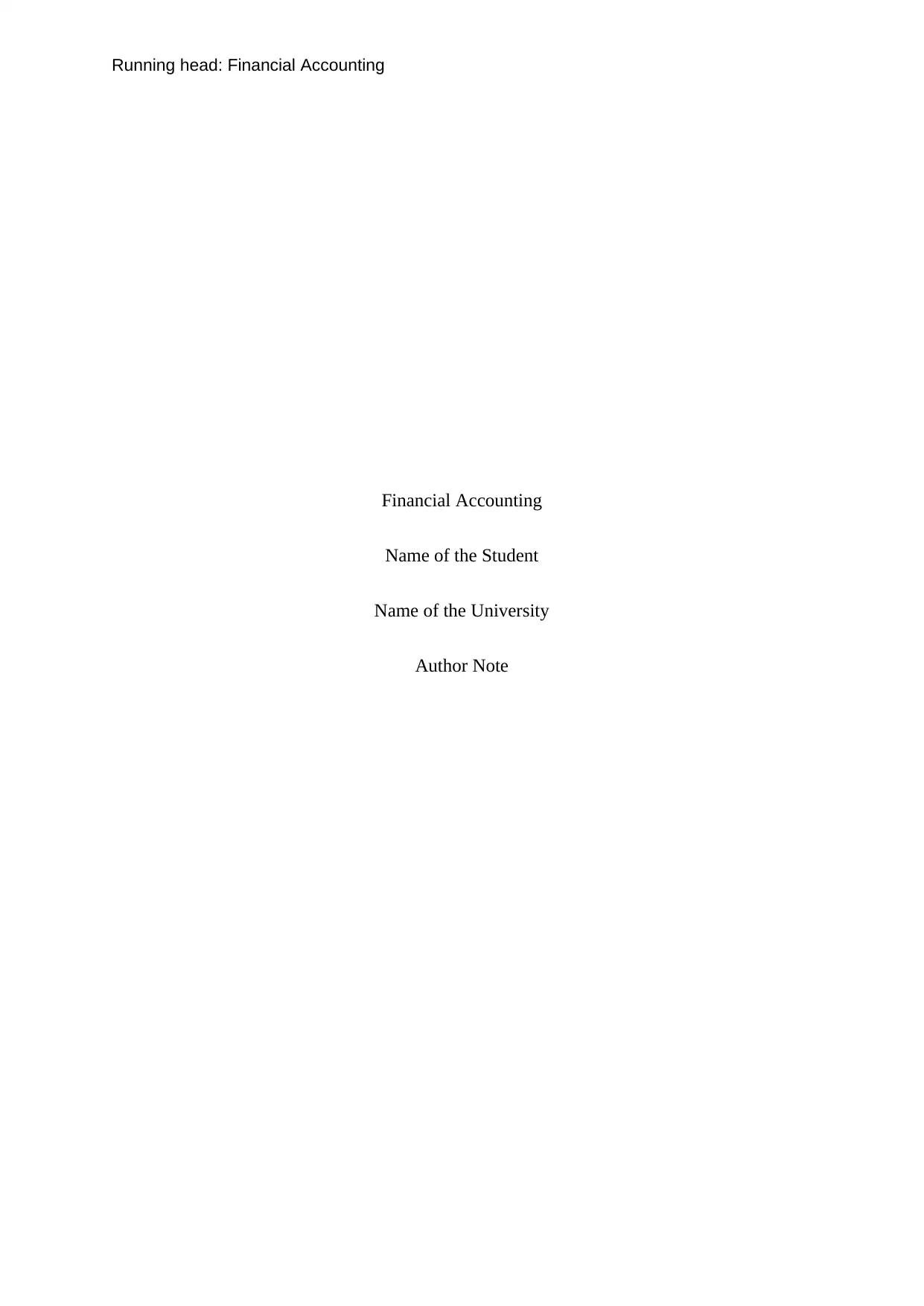
Running head: Financial Accounting
Financial Accounting
Name of the Student
Name of the University
Author Note
Financial Accounting
Name of the Student
Name of the University
Author Note
Paraphrase This Document
Need a fresh take? Get an instant paraphrase of this document with our AI Paraphraser
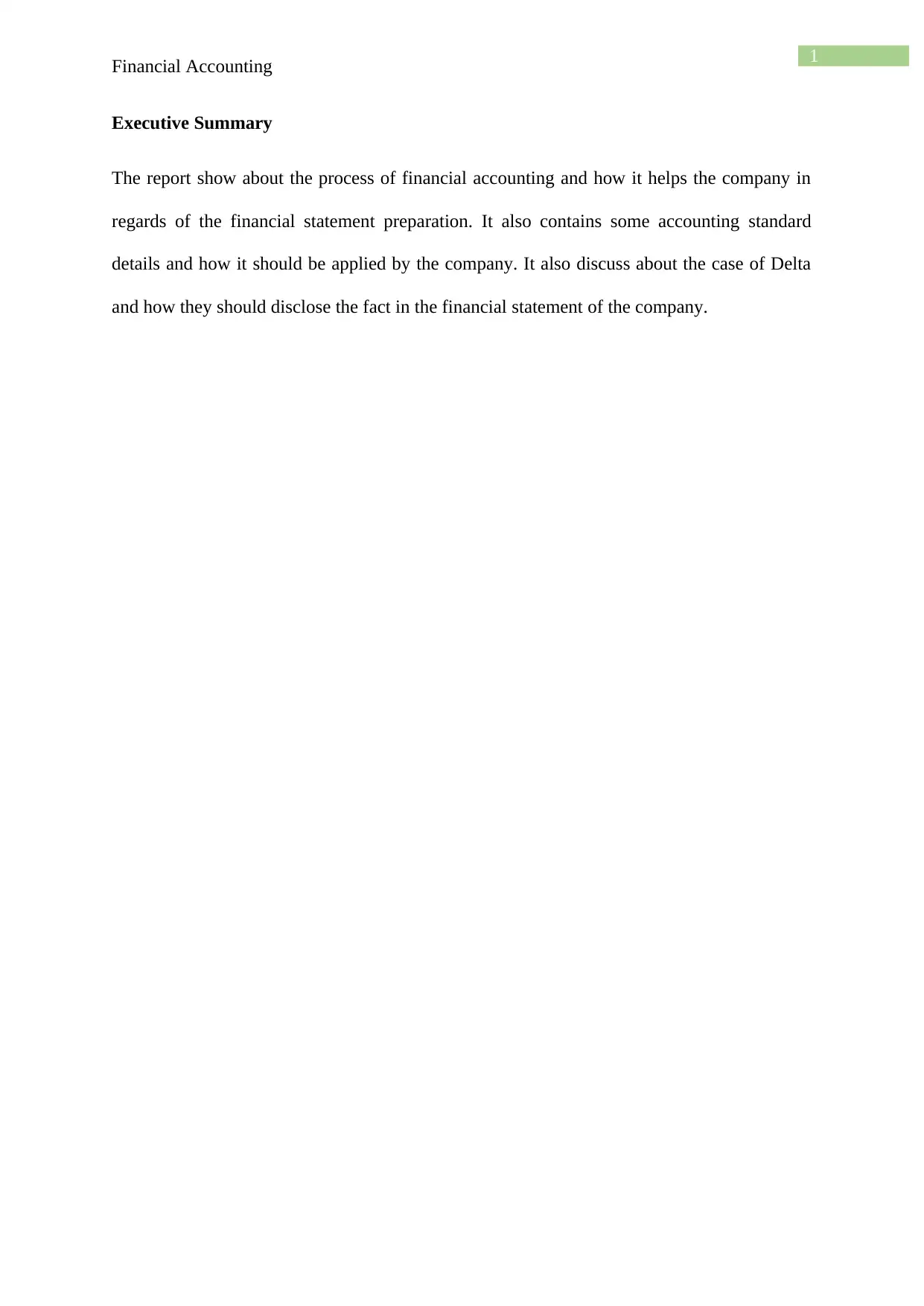
1
Financial Accounting
Executive Summary
The report show about the process of financial accounting and how it helps the company in
regards of the financial statement preparation. It also contains some accounting standard
details and how it should be applied by the company. It also discuss about the case of Delta
and how they should disclose the fact in the financial statement of the company.
Financial Accounting
Executive Summary
The report show about the process of financial accounting and how it helps the company in
regards of the financial statement preparation. It also contains some accounting standard
details and how it should be applied by the company. It also discuss about the case of Delta
and how they should disclose the fact in the financial statement of the company.
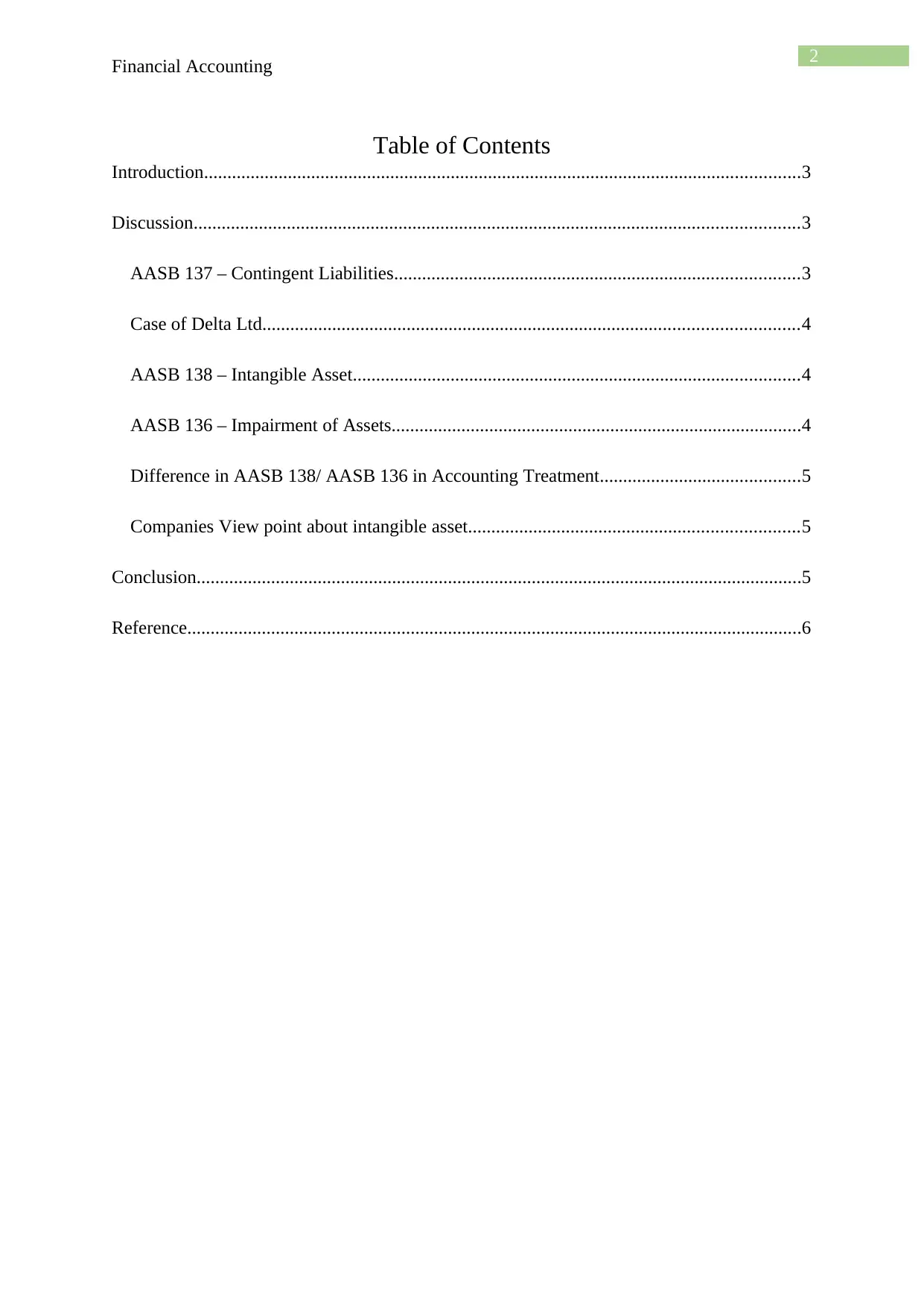
2
Financial Accounting
Table of Contents
Introduction................................................................................................................................3
Discussion..................................................................................................................................3
AASB 137 – Contingent Liabilities.......................................................................................3
Case of Delta Ltd...................................................................................................................4
AASB 138 – Intangible Asset................................................................................................4
AASB 136 – Impairment of Assets........................................................................................4
Difference in AASB 138/ AASB 136 in Accounting Treatment...........................................5
Companies View point about intangible asset.......................................................................5
Conclusion..................................................................................................................................5
Reference....................................................................................................................................6
Financial Accounting
Table of Contents
Introduction................................................................................................................................3
Discussion..................................................................................................................................3
AASB 137 – Contingent Liabilities.......................................................................................3
Case of Delta Ltd...................................................................................................................4
AASB 138 – Intangible Asset................................................................................................4
AASB 136 – Impairment of Assets........................................................................................4
Difference in AASB 138/ AASB 136 in Accounting Treatment...........................................5
Companies View point about intangible asset.......................................................................5
Conclusion..................................................................................................................................5
Reference....................................................................................................................................6
⊘ This is a preview!⊘
Do you want full access?
Subscribe today to unlock all pages.

Trusted by 1+ million students worldwide
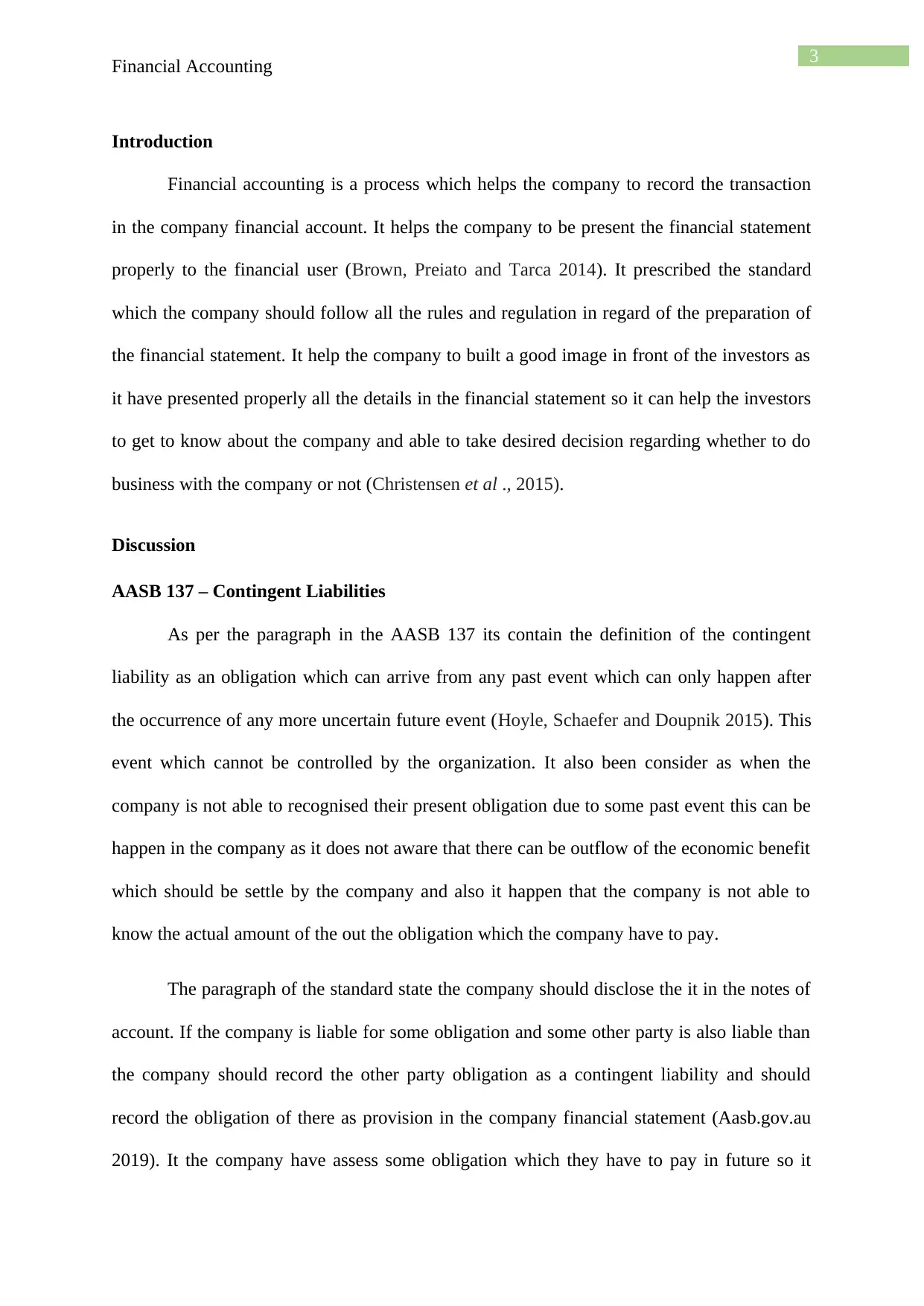
3
Financial Accounting
Introduction
Financial accounting is a process which helps the company to record the transaction
in the company financial account. It helps the company to be present the financial statement
properly to the financial user (Brown, Preiato and Tarca 2014). It prescribed the standard
which the company should follow all the rules and regulation in regard of the preparation of
the financial statement. It help the company to built a good image in front of the investors as
it have presented properly all the details in the financial statement so it can help the investors
to get to know about the company and able to take desired decision regarding whether to do
business with the company or not (Christensen et al ., 2015).
Discussion
AASB 137 – Contingent Liabilities
As per the paragraph in the AASB 137 its contain the definition of the contingent
liability as an obligation which can arrive from any past event which can only happen after
the occurrence of any more uncertain future event (Hoyle, Schaefer and Doupnik 2015). This
event which cannot be controlled by the organization. It also been consider as when the
company is not able to recognised their present obligation due to some past event this can be
happen in the company as it does not aware that there can be outflow of the economic benefit
which should be settle by the company and also it happen that the company is not able to
know the actual amount of the out the obligation which the company have to pay.
The paragraph of the standard state the company should disclose the it in the notes of
account. If the company is liable for some obligation and some other party is also liable than
the company should record the other party obligation as a contingent liability and should
record the obligation of there as provision in the company financial statement (Aasb.gov.au
2019). It the company have assess some obligation which they have to pay in future so it
Financial Accounting
Introduction
Financial accounting is a process which helps the company to record the transaction
in the company financial account. It helps the company to be present the financial statement
properly to the financial user (Brown, Preiato and Tarca 2014). It prescribed the standard
which the company should follow all the rules and regulation in regard of the preparation of
the financial statement. It help the company to built a good image in front of the investors as
it have presented properly all the details in the financial statement so it can help the investors
to get to know about the company and able to take desired decision regarding whether to do
business with the company or not (Christensen et al ., 2015).
Discussion
AASB 137 – Contingent Liabilities
As per the paragraph in the AASB 137 its contain the definition of the contingent
liability as an obligation which can arrive from any past event which can only happen after
the occurrence of any more uncertain future event (Hoyle, Schaefer and Doupnik 2015). This
event which cannot be controlled by the organization. It also been consider as when the
company is not able to recognised their present obligation due to some past event this can be
happen in the company as it does not aware that there can be outflow of the economic benefit
which should be settle by the company and also it happen that the company is not able to
know the actual amount of the out the obligation which the company have to pay.
The paragraph of the standard state the company should disclose the it in the notes of
account. If the company is liable for some obligation and some other party is also liable than
the company should record the other party obligation as a contingent liability and should
record the obligation of there as provision in the company financial statement (Aasb.gov.au
2019). It the company have assess some obligation which they have to pay in future so it
Paraphrase This Document
Need a fresh take? Get an instant paraphrase of this document with our AI Paraphraser
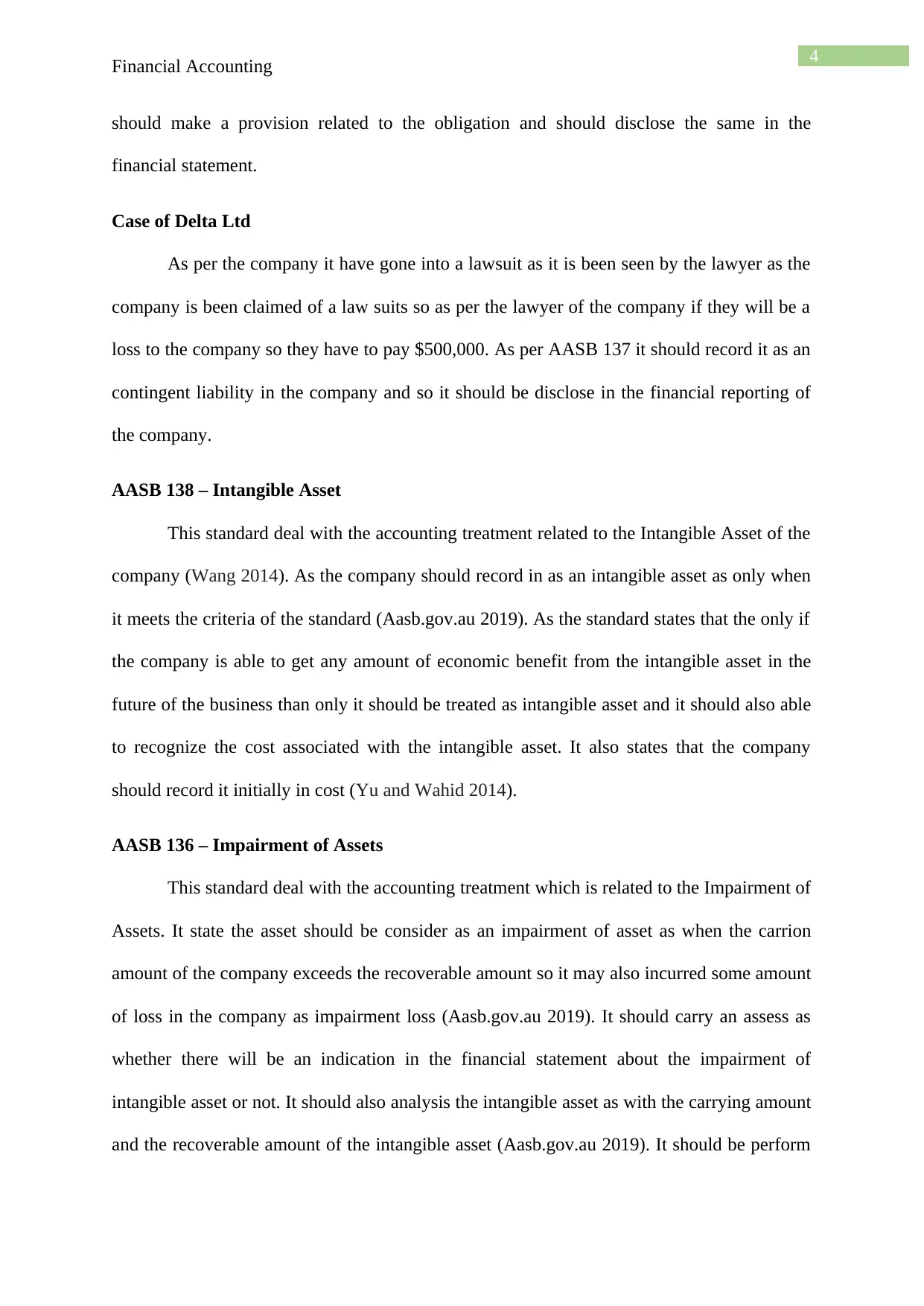
4
Financial Accounting
should make a provision related to the obligation and should disclose the same in the
financial statement.
Case of Delta Ltd
As per the company it have gone into a lawsuit as it is been seen by the lawyer as the
company is been claimed of a law suits so as per the lawyer of the company if they will be a
loss to the company so they have to pay $500,000. As per AASB 137 it should record it as an
contingent liability in the company and so it should be disclose in the financial reporting of
the company.
AASB 138 – Intangible Asset
This standard deal with the accounting treatment related to the Intangible Asset of the
company (Wang 2014). As the company should record in as an intangible asset as only when
it meets the criteria of the standard (Aasb.gov.au 2019). As the standard states that the only if
the company is able to get any amount of economic benefit from the intangible asset in the
future of the business than only it should be treated as intangible asset and it should also able
to recognize the cost associated with the intangible asset. It also states that the company
should record it initially in cost (Yu and Wahid 2014).
AASB 136 – Impairment of Assets
This standard deal with the accounting treatment which is related to the Impairment of
Assets. It state the asset should be consider as an impairment of asset as when the carrion
amount of the company exceeds the recoverable amount so it may also incurred some amount
of loss in the company as impairment loss (Aasb.gov.au 2019). It should carry an assess as
whether there will be an indication in the financial statement about the impairment of
intangible asset or not. It should also analysis the intangible asset as with the carrying amount
and the recoverable amount of the intangible asset (Aasb.gov.au 2019). It should be perform
Financial Accounting
should make a provision related to the obligation and should disclose the same in the
financial statement.
Case of Delta Ltd
As per the company it have gone into a lawsuit as it is been seen by the lawyer as the
company is been claimed of a law suits so as per the lawyer of the company if they will be a
loss to the company so they have to pay $500,000. As per AASB 137 it should record it as an
contingent liability in the company and so it should be disclose in the financial reporting of
the company.
AASB 138 – Intangible Asset
This standard deal with the accounting treatment related to the Intangible Asset of the
company (Wang 2014). As the company should record in as an intangible asset as only when
it meets the criteria of the standard (Aasb.gov.au 2019). As the standard states that the only if
the company is able to get any amount of economic benefit from the intangible asset in the
future of the business than only it should be treated as intangible asset and it should also able
to recognize the cost associated with the intangible asset. It also states that the company
should record it initially in cost (Yu and Wahid 2014).
AASB 136 – Impairment of Assets
This standard deal with the accounting treatment which is related to the Impairment of
Assets. It state the asset should be consider as an impairment of asset as when the carrion
amount of the company exceeds the recoverable amount so it may also incurred some amount
of loss in the company as impairment loss (Aasb.gov.au 2019). It should carry an assess as
whether there will be an indication in the financial statement about the impairment of
intangible asset or not. It should also analysis the intangible asset as with the carrying amount
and the recoverable amount of the intangible asset (Aasb.gov.au 2019). It should be perform
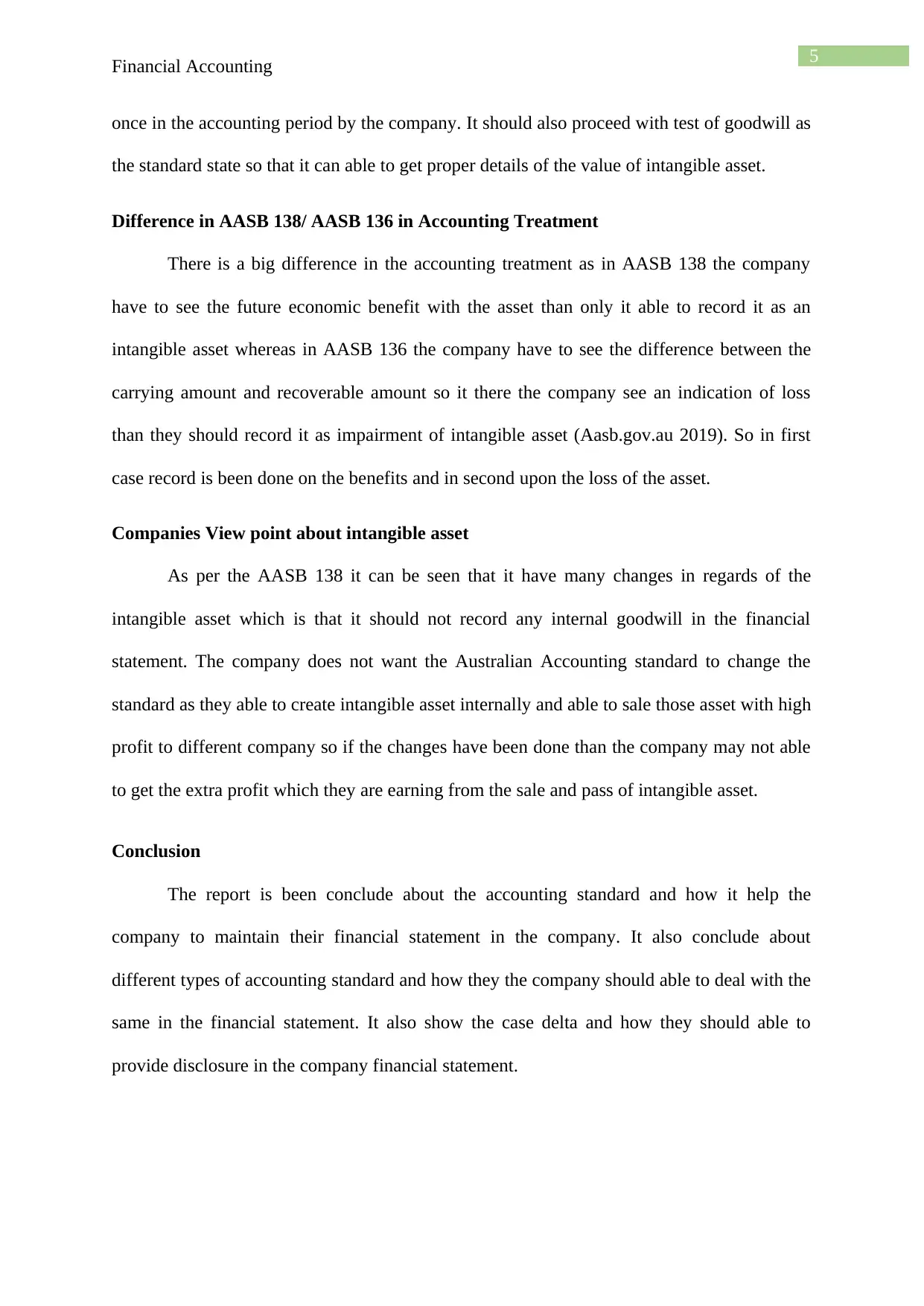
5
Financial Accounting
once in the accounting period by the company. It should also proceed with test of goodwill as
the standard state so that it can able to get proper details of the value of intangible asset.
Difference in AASB 138/ AASB 136 in Accounting Treatment
There is a big difference in the accounting treatment as in AASB 138 the company
have to see the future economic benefit with the asset than only it able to record it as an
intangible asset whereas in AASB 136 the company have to see the difference between the
carrying amount and recoverable amount so it there the company see an indication of loss
than they should record it as impairment of intangible asset (Aasb.gov.au 2019). So in first
case record is been done on the benefits and in second upon the loss of the asset.
Companies View point about intangible asset
As per the AASB 138 it can be seen that it have many changes in regards of the
intangible asset which is that it should not record any internal goodwill in the financial
statement. The company does not want the Australian Accounting standard to change the
standard as they able to create intangible asset internally and able to sale those asset with high
profit to different company so if the changes have been done than the company may not able
to get the extra profit which they are earning from the sale and pass of intangible asset.
Conclusion
The report is been conclude about the accounting standard and how it help the
company to maintain their financial statement in the company. It also conclude about
different types of accounting standard and how they the company should able to deal with the
same in the financial statement. It also show the case delta and how they should able to
provide disclosure in the company financial statement.
Financial Accounting
once in the accounting period by the company. It should also proceed with test of goodwill as
the standard state so that it can able to get proper details of the value of intangible asset.
Difference in AASB 138/ AASB 136 in Accounting Treatment
There is a big difference in the accounting treatment as in AASB 138 the company
have to see the future economic benefit with the asset than only it able to record it as an
intangible asset whereas in AASB 136 the company have to see the difference between the
carrying amount and recoverable amount so it there the company see an indication of loss
than they should record it as impairment of intangible asset (Aasb.gov.au 2019). So in first
case record is been done on the benefits and in second upon the loss of the asset.
Companies View point about intangible asset
As per the AASB 138 it can be seen that it have many changes in regards of the
intangible asset which is that it should not record any internal goodwill in the financial
statement. The company does not want the Australian Accounting standard to change the
standard as they able to create intangible asset internally and able to sale those asset with high
profit to different company so if the changes have been done than the company may not able
to get the extra profit which they are earning from the sale and pass of intangible asset.
Conclusion
The report is been conclude about the accounting standard and how it help the
company to maintain their financial statement in the company. It also conclude about
different types of accounting standard and how they the company should able to deal with the
same in the financial statement. It also show the case delta and how they should able to
provide disclosure in the company financial statement.
⊘ This is a preview!⊘
Do you want full access?
Subscribe today to unlock all pages.

Trusted by 1+ million students worldwide
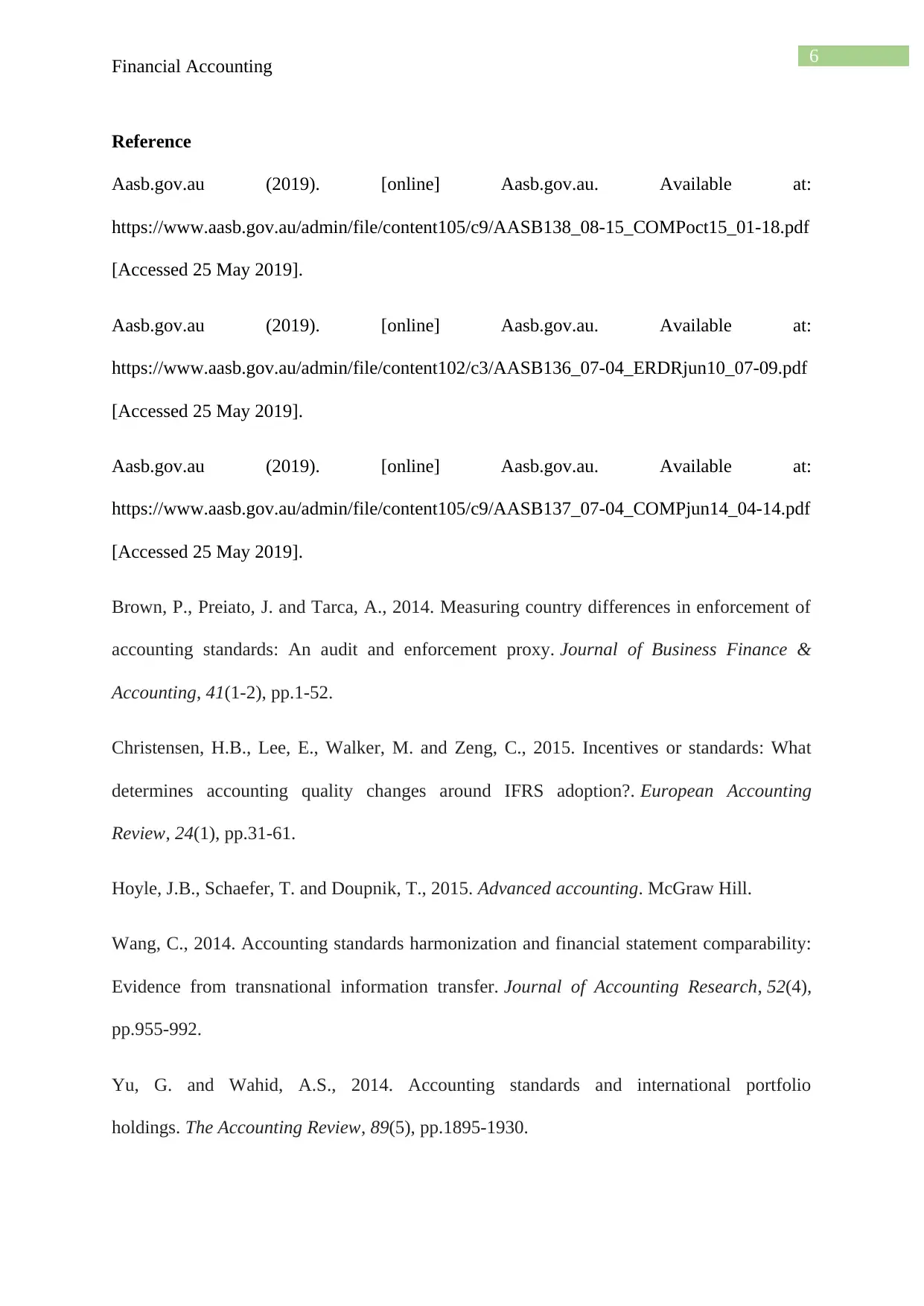
6
Financial Accounting
Reference
Aasb.gov.au (2019). [online] Aasb.gov.au. Available at:
https://www.aasb.gov.au/admin/file/content105/c9/AASB138_08-15_COMPoct15_01-18.pdf
[Accessed 25 May 2019].
Aasb.gov.au (2019). [online] Aasb.gov.au. Available at:
https://www.aasb.gov.au/admin/file/content102/c3/AASB136_07-04_ERDRjun10_07-09.pdf
[Accessed 25 May 2019].
Aasb.gov.au (2019). [online] Aasb.gov.au. Available at:
https://www.aasb.gov.au/admin/file/content105/c9/AASB137_07-04_COMPjun14_04-14.pdf
[Accessed 25 May 2019].
Brown, P., Preiato, J. and Tarca, A., 2014. Measuring country differences in enforcement of
accounting standards: An audit and enforcement proxy. Journal of Business Finance &
Accounting, 41(1-2), pp.1-52.
Christensen, H.B., Lee, E., Walker, M. and Zeng, C., 2015. Incentives or standards: What
determines accounting quality changes around IFRS adoption?. European Accounting
Review, 24(1), pp.31-61.
Hoyle, J.B., Schaefer, T. and Doupnik, T., 2015. Advanced accounting. McGraw Hill.
Wang, C., 2014. Accounting standards harmonization and financial statement comparability:
Evidence from transnational information transfer. Journal of Accounting Research, 52(4),
pp.955-992.
Yu, G. and Wahid, A.S., 2014. Accounting standards and international portfolio
holdings. The Accounting Review, 89(5), pp.1895-1930.
Financial Accounting
Reference
Aasb.gov.au (2019). [online] Aasb.gov.au. Available at:
https://www.aasb.gov.au/admin/file/content105/c9/AASB138_08-15_COMPoct15_01-18.pdf
[Accessed 25 May 2019].
Aasb.gov.au (2019). [online] Aasb.gov.au. Available at:
https://www.aasb.gov.au/admin/file/content102/c3/AASB136_07-04_ERDRjun10_07-09.pdf
[Accessed 25 May 2019].
Aasb.gov.au (2019). [online] Aasb.gov.au. Available at:
https://www.aasb.gov.au/admin/file/content105/c9/AASB137_07-04_COMPjun14_04-14.pdf
[Accessed 25 May 2019].
Brown, P., Preiato, J. and Tarca, A., 2014. Measuring country differences in enforcement of
accounting standards: An audit and enforcement proxy. Journal of Business Finance &
Accounting, 41(1-2), pp.1-52.
Christensen, H.B., Lee, E., Walker, M. and Zeng, C., 2015. Incentives or standards: What
determines accounting quality changes around IFRS adoption?. European Accounting
Review, 24(1), pp.31-61.
Hoyle, J.B., Schaefer, T. and Doupnik, T., 2015. Advanced accounting. McGraw Hill.
Wang, C., 2014. Accounting standards harmonization and financial statement comparability:
Evidence from transnational information transfer. Journal of Accounting Research, 52(4),
pp.955-992.
Yu, G. and Wahid, A.S., 2014. Accounting standards and international portfolio
holdings. The Accounting Review, 89(5), pp.1895-1930.
1 out of 7
Related Documents
Your All-in-One AI-Powered Toolkit for Academic Success.
+13062052269
info@desklib.com
Available 24*7 on WhatsApp / Email
![[object Object]](/_next/static/media/star-bottom.7253800d.svg)
Unlock your academic potential
Copyright © 2020–2025 A2Z Services. All Rights Reserved. Developed and managed by ZUCOL.





